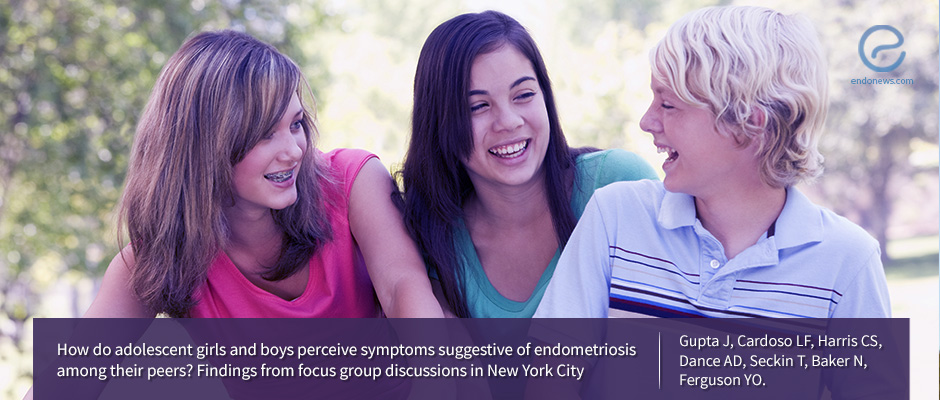How do adolescent girls and boys perceive symptoms suggestive of endometriosis among their peers?
Jul 4, 2018
Findings from focus group discussions in New York City.
Key Points
Highlight:
- This study qualitatively examined how, among adolescents, endometriosis, and symptoms suggestive of endometriosis is perceived at the family, peer/school and community/society levels.
Background:
- Endometriosis, a chronic condition characterized by cells similar to the uterine lining that exist outside of the uterus, is estimated to impact 10% of women of reproductive age.
- Symptoms of endometriosis, including pelvic pain, back and nerve pain, and gastrointestinal pain, often begin in adolescence.
- Yet, research on the experience of these debilitating symptoms among young people is scarce.
- Of particular concern is the influence of adolescent girls’ social context.
Key points:
- Ethnically diverse girls and boys ages 14–18 (n=54) residing in New York City have participated.
- Fifteen themes emerged and were distilled to eight cross-cutting factors that influence perceptions of endometriosis at different levels of the ecological model.
- Distrust of community healthcare providers
- The societal stigma of menstruation
- Peer stigma of endometriosis symptoms
- Distrust of school health care providers
- Lack of endometriosis knowledge among peers and school personnel
- Inequitable gender norms
- The invisibility of symptoms and the stigma of teen sex among parents.
- Further, these factors may compound symptoms’ impact on individual girl’s social, educational and emotional wellbeing.
Conclusions:
- The findings from Dr. Gupta’s group underscore the importance of understanding the social environment of girls experiencing symptoms suggestive of endometriosis and educating and engaging their peers, family, and school personnel to create a supportive, informed social climate.
- Efforts should specifically include stigma reduction campaigns targeted towards female and male adolescents.
Limitations:
- This study used a convenience sample of adolescents recruited through non-profit leaders and teachers with an interest in the topic, which may have biased the sample towards participants with more willingness to discuss topics related to women’s health.
Lay Summary
Endometriosis, a chronic condition characterized by cells similar to the uterine lining that exist outside of the uterus, is estimated to impact 10% of women of reproductive age. In the USA, that approximates to some 7.4 million women. Endometriosis has been documented to adversely impact multiple aspects of women and girls’ lives. Despite growing recognition that endometriosis symptoms often begin in adolescence, research with adolescent populations is scarce. Thus, Dr. Gupta’s group from George Mason University aims to qualitatively examine how endometriosis and its symptoms are perceived at the family, peer/school and community/societal levels among an ethnically mixed sample of adolescent boys and girls.
Ethnically diverse girls and boys ages 14–18 (n=54) residing in New York City have participated in this study. Fifteen themes emerged and were distilled to eight cross-cutting factors that influence perceptions of endometriosis at different levels of the ecological model: distrust of community healthcare providers, societal stigma of menstruation, peer stigma of endometriosis symptoms, distrust of school healthcare providers, lack of endometriosis knowledge among peers and school personnel, inequitable gender norms, invisibility of symptoms and the stigma of teen sex among parents. Further, these factors may compound symptoms’ impact on individual girl’s social, educational and emotional wellbeing.
In conclusion, the findings from Dr. Gupta’s group underscore the importance of understanding the social environment of girls experiencing symptoms suggestive of endometriosis and educating and engaging their peers, family, and school personnel to create a supportive, informed social climate. Efforts should specifically include stigma reduction campaigns targeted towards female and male adolescents.
The main limitation is that the study used a convenience sample of adolescents recruited through non-profit leaders and teachers with an interest in the topic, which may have biased the sample towards participants with more willingness to discuss topics related to women’s health.
Research Source: https://www.ncbi.nlm.nih.gov/pubmed/?term=29866728
Adolescence Endometriosis Social environment

